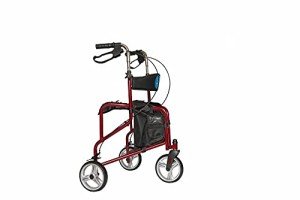
Rollator With Storage
Add a review FollowOverview
-
Founded Date December 30, 2025
-
Sectors Chemical Engineering
-
Posted Jobs 0
-
Viewed 91
Company Description
Learn To Communicate Adjustable Walker To Your Boss
Understanding Adjustable Walkers: A Comprehensive Guide
Adjustable walkers are vital mobility aids developed to offer stability and assistance to people with mobility obstacles. They enhance self-reliance, safety, and confidence Rollator For Elderly people recovering from surgery, dealing with chronic conditions, or facing age-related mobility problems. This article looks into the functions, types, benefits, and typical FAQs connected to adjustable walkers, offering insights for potential users and caretakers.
What is an Adjustable Walker?
An adjustable walker is a mobility aid that typically includes a Lightweight 3-Wheel Rollator for Easy Mobility frame with 4 legs, geared up with handgrips for assistance. It can be gotten used to accommodate different heights, ensuring users attain a comfortable wrist position while supporting their weight. Adjustable walkers been available in various designs, each customized to particular requirements.
Secret Features of Adjustable Walkers
- Height Adjustment: Most adjustable walkers have telescoping legs, enabling users to easily modify the height to suit their stature.
- Weight Capacity: Different designs accommodate differing weight limitations, dealing with a broad demographic.
- Foldability: Many walkers are collapsible, making them simple to shop and transportation.
- Wheels vs. No Wheels: Some walkers come with wheels on the front legs, while others have a basic style without wheels, promoting stability.
- Additional Accessories: Walkers can typically be equipped with trays, baskets, or cup holders for added convenience.
| Function | Description |
|---|---|
| Height Adjustment | Telescoping legs for tailored height settings |
| Weight Capacity | Varies by design, supporting various body weights |
| Foldability | Collapsible design for easy transport and storage |
| Wheels | Offered in both wheeled and non-wheeled choices |
| Additional Accessories | Trays, baskets, and cup holders for user benefit |
Types of Adjustable Walkers
- Requirement Walkers: Traditional designs with 4 legs. Best for those looking for optimum stability.
- Wheeled Walkers (Rollators): Walkers with two or more wheels, permitting for easier maneuvering.
- Hemi Walkers: Designed for people with the use of one hand, including a single arm assistance for included stability.
- Child Walkers: Specifically developed for babies finding out to stroll, promoting safety and support throughout early mobility.
Benefits of Using Adjustable Walkers
Boost Independence
- Enhanced Mobility: Adjustable walkers permit users to browse their environments with more ease and self-confidence, promoting a sense of independence.
- Accessibility: With the ideal walker, users can preserve their lifestyle and participate in activities they take pleasure in without assistance.
Injury Prevention
- Stability and Support: Walker users can maintain better balance and avoid falls, which are especially essential for seniors and individuals recuperating from surgical treatment.
- Lowered Strain: Proper use of a Days Aluminum Tri-Wheel Walker – Light & Easy can ease stress on joints and muscles, lessening the threat of injury during mobility.
Convenience and Customization
- Adjustable Settings: Walkers can be tailored to each user’s height and comfort, offering a more individualized experience.
- Additional Features: Options for accessories help in accommodating individual needs, making it possible for users to carry products while moving.
Expenses and Considerations
The price of adjustable walkers ranges depending on functions, products, and brand name. Here’s a summary of the typical expenses related to different types:
| Durable Walker Type | Average Cost |
|---|---|
| Requirement Walkers | ₤ 50 – ₤ 100 |
| Wheeled Walkers | ₤ 75 – ₤ 200 |
| Hemi Walkers | ₤ 60 – ₤ 150 |
| Infant Walkers | ₤ 30 – ₤ 70 |
Frequently Asked Questions (FAQs)
1. How do I know which adjustable walker is ideal for me?
The ideal adjustable walker depends on your particular needs, physical condition, and environment. It’s necessary to seek advice from a healthcare professional to figure out the most appropriate type.
2. Can I change the height of any walker?
The majority of adjustable walkers include a height-adjustment mechanism. However, not all walkers are adjustable. It’s crucial to take a look at product specifications before acquiring.
3. Are wheeled walkers safe to use?
Yes, wheeled walkers (or rollators) are safe for users who can browse them properly. They frequently consist of brakes for added safety when stationary.
4. How do I take care of my adjustable walker?
Regular care involves cleaning the walker with mild soap and water, looking for wear on grips and wheels, and making sure mechanisms operate efficiently.
5. Can I take my adjustable walker on public transport?
Yes, numerous adjustable walkers are foldable and designed for easy transportation. However, it’s advisable to check the specific standards of the transport service.

6. Do I need help to use an adjustable walker?
Numerous users can operate adjustable walkers separately, particularly when correctly fitted to their height. Nevertheless, those with severe mobility problems might benefit from help.
Adjustable walkers are important tools for enhancing mobility, self-reliance, and safety. With a variety of designs and designs, individuals can discover a walker customized to their needs. Caretakers and users alike need to value the value of speaking with healthcare specialists to make educated decisions concerning mobility aids. Comprehending the functions, benefits, and considerations of adjustable walkers empowers people to preserve an active lifestyle, enhancing their quality of life in spite of mobility obstacles.
